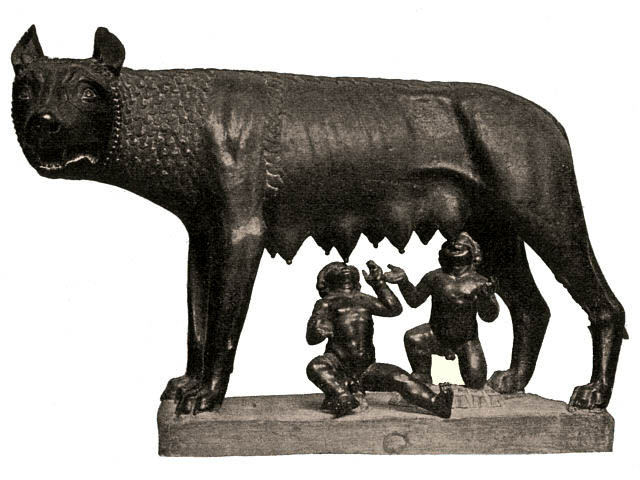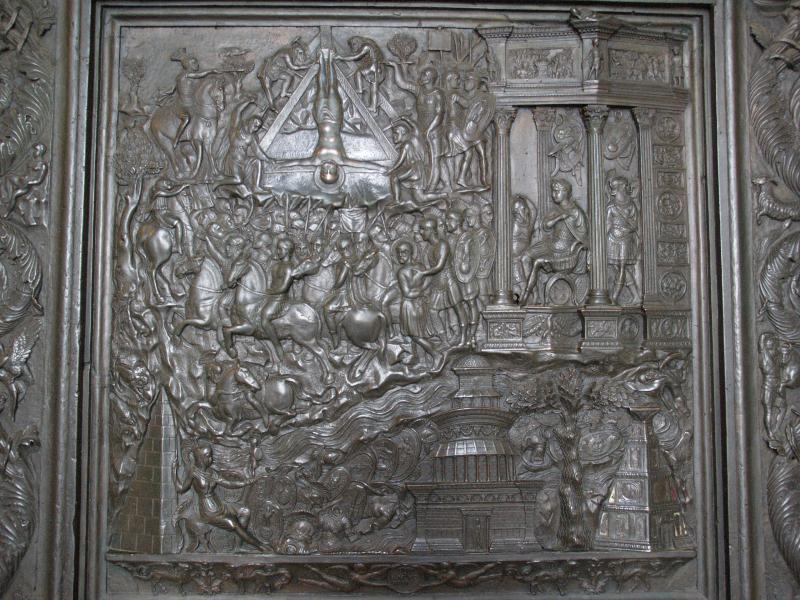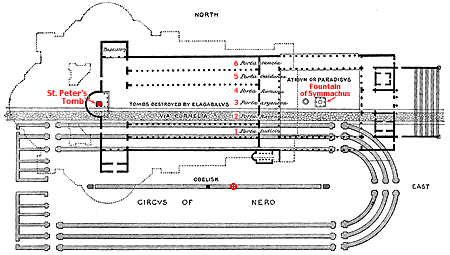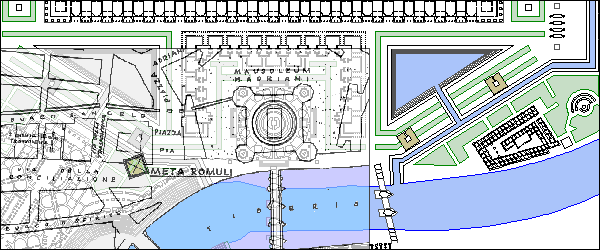The Meta Romuli and the Mystery of St. Peter's Crucifixion
 As some of you know, I started writing the successor to In the Mission, my first published novel. This time around, part of the action will take place in my home town, Rome (Eternal, not New York). Research has been going strong, with the week I spent in Italy dedicated for the most part to research the setting and the details of the plot.
As some of you know, I started writing the successor to In the Mission, my first published novel. This time around, part of the action will take place in my home town, Rome (Eternal, not New York). Research has been going strong, with the week I spent in Italy dedicated for the most part to research the setting and the details of the plot.
One of the things that stands out about Rome and its institution is the obsession with twins. Once the last (Etruscan) king was abolished, Rome created itself as a Republic with two consuls at its head. The basic idea was that since there were two, one could keep the other in check. This is centuries later reprised in the notion of two co-equal emperors (augusti) which segued into the separation of the one Roman Empire into two.
This obsession with twins stems with the very birth of the city, founded as it was by twin brothers, Romulus and Remus. In a foreshadowing of how this twin thing was going to work out, one twin (Romulus) killed the other (Remus) at the founding. When Romulus drew the city limits of Rome, Remus hopped over them. Romulus, incensed, killed his brother. Apparently, 18-year-olds of the time were no more likely to restrain themselves than today.
Centuries later, the Roman Republic had established itself as the premier power of the Mediterranean. Internally, the only super-power of the time was going through upheaval. The state was torn by internal strife and civil war. Mighty generals commanded giant armies that turned against each other and the republic. Then, the most successful of them all succeeded in eliminating all rivals and a new peace was born.
The man that succeeded in this was one Gaius Julius Caesar Octavianus, better known today by his honorific Augustus. Under his reign, Egypt became part of the Roman Empire (which will become relevant shortly) after her last ruler, Cleopatra, died. Also under his reign, a child was born in Bethlehem.
Sixty-something years after that child was born, the late grown man’s first follower, a Simon Peter, was executed in Rome. Tradition has it that this man, when told he was going to be crucified, asked to be crucified upside down. Allegedly, that’s because his master was crucified right side up, and he didn’t think he deserved the same (dubious) honor. This man, of course, is now better known as Saint Peter, first pope of the Catholic Church.
 The legend also specifies that Simon Peter was crucified “between the two pyramids”. Strangely, the form of crucifixion and the location are pretty much the only details that came down to us, along with a possible date. The tomb of St. Peter was then placed along the via Triumphalis, the road leading from the North-West into Rome (also according to legend).
The legend also specifies that Simon Peter was crucified “between the two pyramids”. Strangely, the form of crucifixion and the location are pretty much the only details that came down to us, along with a possible date. The tomb of St. Peter was then placed along the via Triumphalis, the road leading from the North-West into Rome (also according to legend).
The only ancient pyramid left standing in Rome nowadays is the pyramid of Cestius. The reason it is left standing is that it was incorporated into the defensive walls of emperor Aurelian. Pressed for time, the emperor made the walls reach around the city in a circuit that included major buildings, such as an amphitheater, barracks, and of course this pyramid.
In the Middle Ages, though, a second pyramid was standing. It was near Saint Peter’s Basilica (the old one, not the new one you can visit today). This pyramid was first stripped of its marble face (which went to the construction of Old St. Peter’s). Later, the concrete-and-brick core was first cut in half in 1499 to build a triumphal road, then completely torn down to make room for a minor church (Santa Maria in Traspontina).
We know about these pyramids. The story of the queen who killed herself, the legend of her beauty, the riches of her land, and the conquest of Egypt as the last major act of civil war made all things Egyptian fashionable in Rome. The craze, of course, extended to tombs – after all, it was known that the pyramids were the tombs of the pharaohs.
The Middle Ages must have been a strange time in history. Despite the fact that the inscription on the Pyramid of Cestius clearly states whose building it is (hence the fact we call it Pyramid of Cestius), the Romans believed it was the tomb of Remus, the city’s founding twin. The other pyramid was then assumed to be the tomb of Romulus.
Romans must also have been obsessed with chariot races. The chariots would turn around a marker in the circus, a conical object that was named a meta. The word meta is still retained in Italian to mean, goal. All conical-ish objects were then named metae, including these two tombs, the Meta Romuli and Meta Remi.
(Incidentally, he probable location of a tomb of Romulus would have been on the Quirinal, which was one of the seven original hills of Rome. The Meta Romuli stood outside the city in a swamp, a highly unlikely place for the tomb of the founder.)
If you look at the image of the bronze doors to St. Peter’s, you’ll notice three monuments at the bottom: a pyramid with a face broken up in large stones, a fancy monument with lots of columns around, and a very strange pyramid with a flat top and decorations on the face. The fancy monument is the Tomb of Hadrian, Roman emperor. It stood on the banks of the Tiber opposite town, near (you guessed it) St. Peter’s. You can still see it, although it has lost most of its fancy. It’s Castel Sant’Angelo, the pope’s fortress in Rome.
The pyramid with the stone face is very recognizable: it’s the Pyramid of Cestius, which still looks exactly like that. The other pyramid is identified as the Meta Romuli, which apparently wasn’t as plain as the Meta Remi. It was also reported to be taller than the one still standing, although not by much.
 The motif of the crucifixion of Saint Peter is fairly common in the Middle Ages, and the two pyramids are frequently featured prominently. Here is a depiction by Giotto, one of the premier pre-Renaissance artists in Italy. Notice how in this depiction, too, the pyramids are different. One is plain (Cestius), the other fancy (in this case with a tree on top and decorations on the side).
The motif of the crucifixion of Saint Peter is fairly common in the Middle Ages, and the two pyramids are frequently featured prominently. Here is a depiction by Giotto, one of the premier pre-Renaissance artists in Italy. Notice how in this depiction, too, the pyramids are different. One is plain (Cestius), the other fancy (in this case with a tree on top and decorations on the side).
There is, though, one giant problem with this depiction. Peter was said to be crucified “between the two pyramids.” The problem is that the two pyramids are really very far from each other. The Meta Remi is at the South end of the city, near the Porta Ostiense (modern Porta San Paolo). The Meta Romuli was near Saint Peter’s, at the West end of town. To say that the saint was crucified upside down between the two metae makes no sense at all. It would be like explaining that a particular shop is between the Statue of Liberty and the Bronx Zoo.
(It really surprises me that nobody in the Middle Ages noticed that. But then, they managed to believe that a pyramid that bears the inscription, “Gaius Cestius, son of Lucius, of the gens Pobilia” could be the tomb of Remus.)
Where was Saint Peter crucified? Let’s assume that the legend is correct and that he was crucified between two pyramids. If the two pyramids cannot be the ones identified in the Middle Ages, which ones were they?
A little logic might help here. Saint Peter’s (the church) stands in the Ager Vaticanus, the swamp I was talking about. It stands to reason that the man was crucified there, which makes the Meta Romuli the more likely location. Also, the Meta Romuli was at the intersection of the via Triumphalis (where Saint Peter’s tomb was allegedly located) and the via Cornelia (where the Circus Neronis stood).
 There is a problem with the legend: the tomb of Saint Peter is said to be on the via Triumphalis, but that’s not correct. The tomb was near the Circus Neronis on the via Cornelia, which is where they built the church honoring the tomb honoring the saint. (Saint Peter’s is still built there, with the “modern” church built on top of the ancient church built on top of the ancient circus.)
There is a problem with the legend: the tomb of Saint Peter is said to be on the via Triumphalis, but that’s not correct. The tomb was near the Circus Neronis on the via Cornelia, which is where they built the church honoring the tomb honoring the saint. (Saint Peter’s is still built there, with the “modern” church built on top of the ancient church built on top of the ancient circus.)
We could think that the tomb was moved from the via Triumphalis to the via Cornelia. Certainly possible. But the question comes up, why was he buried at the via Triumphalis in the first place? Isn’t it likely that he was buried there because that’s where he died?
Let’s assume for the sake of argument that Simon Peter was crucified along the via Triumphalis between two pyramids. One of the pyramids is know, it’s the Meta Romuli. Where is the other one? We certainly don’t know of any other pyramids standing there.
I think we have three main options to consider:
- Cemeteries were clustered back then as they are today. A tomb would not be placed randomly, but alongside a whole lot of other tombs. It is very possible that the Meta Romuli was flanked by an unknown pyramid that got destroyed before history recorded it. After all, we have no evidence of the Meta from ancient times, only from Medieval documents.
- There was a monument standing close to the Meta, the Therebintum Neronis. It wasn’t shaped like a pyramid, being more cylindrical and tall, but the location would have been right: along the via Triumphalis. The Therebintum was named after the marble used to cover it (travertine).
- There was a meta in the circus of Nero, of course. If Peter would have been crucified between the two metae, that would have meant on the via Cornelia, close to the via Triumphalis.
 Interestingly, Piranesis fanciful map of the Campus Martius, the Ichnographia Campus Martius, has an interesting detail regarding pyramids. In the detail of Hadrian’s tomb, it has it flanked by two triangular ponds, ornamented by two pyramids each. One of the pyramids is almost exactly on the location of the Meta Romuli (see image).
Interestingly, Piranesis fanciful map of the Campus Martius, the Ichnographia Campus Martius, has an interesting detail regarding pyramids. In the detail of Hadrian’s tomb, it has it flanked by two triangular ponds, ornamented by two pyramids each. One of the pyramids is almost exactly on the location of the Meta Romuli (see image).
The problem with Piranesis map is that the Meta cannot have been built as an ornament to the tomb of Hadrian, since the fashion of building pyramids was long dead. Instead, Hadrian’s tomb was erected more than a century after the pyramid. But why would Piranesi think there had to be two flanking pyramids on each side? (Notice that they are marked as pyramis in the original map.)
Notice that it was common to place markers on each side of a building. The entrance to the Mausoleum Augusti, the tomb of the early emperors, was adorned with two enormous obelisks pilfered from (you guessed it) Egypt. This was in keeping with the “twin” theme that Romans so loved. But four monuments, two to each side?
Piranesis map is fanciful, but has a core of truth. Could it be that there remained some faint memory of a second monument of pyramidal form near the certain monument of the Meta Romuli? A monument so close on Piranesis map to the Meta, that it could really have been the second pyramid of the pair between which Saint Peter was crucified.
In conclusion, it seems clear that Simon Peter was crucified along the via Cornelia or the via Triumphalis, close to the Meta Romuli. The presence of a second pyramidal building (a destroyed pyramid, the Terebintum, or the meta of the circus) would confirm the accuracy of the legend, since the alternative pyramid (the one of Cestius) is not suitable for a location description.
[Note: Some scholars say that the indication, “inter duas metas” refers to the actual two goal markers of the Circus of Nero (see for example this outstanding article).The indication would then just mean, “on the spine of the circus,” and the entire depiction of the scene using the two monuments called metae in the Middle Ages could be just nonsense.
There is good reason to assume that’s true. The Circus of Nero is known to have been the location of much of the persecution of Christians in 64/65; the second meta to which the Acts of Peter refer is nowhere to be found; the ancient sources (as outlined in the article) agree on the proximity to the Circus.]